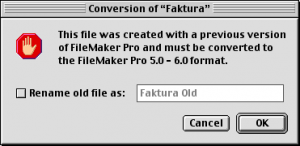

- FILEMAKER PRO 6 FILE IMPORT DRIVERS
- FILEMAKER PRO 6 FILE IMPORT CODE
- FILEMAKER PRO 6 FILE IMPORT PASSWORD
I suggest you play with this for a while and try to add more data to the import tree. You will see this field in the Filemaker's import dialog, and you will be able to map it to a field in the target table - same as importing from a "real" Filemaker file. This will be channeled to a FIELD named "RootID".

Then it gets the value from the root attribute of the element of the element. It creates a record (ROW) for each top-level element in the section. Here's an XSLT stylesheet that you could use as your starting point. Is there somewhere in either filemaker or access that i need to specify the Schema file? Because i think that's what the problem might be. The problem is that every time i select the XML file to import and then the style sheet I get an error in attempting to import.

The FileMaker Pro SQL Query builder dialog box appears.
FILEMAKER PRO 6 FILE IMPORT PASSWORD
To skip this dialog box in the future, select Save user name and password (this option is only available if you’re importing into an existing FileMaker Pro file). Enter the user name and password (if any) for the data source you chose.
FILEMAKER PRO 6 FILE IMPORT DRIVERS
Most server-based ODBC drivers require the data source to be open, but the requirement varies depending on the driver.
FILEMAKER PRO 6 FILE IMPORT CODE
Otherwise, when a Unicode string containing non-English characters is passed to Microsoft SQL Server, you may lose any data that doesn’t exist in the Microsoft SQL Server code page. Note Because Microsoft SQL Server supports both Unicode and non-Unicode field types, you must prefix all Unicode strings with an uppercase "N" (which stands for "National" in the SQL-92 standard). SQL is passed through the ODBC interface to the data source, performing queries such as SELECT first_name, last_name FROM customers WHERE city=N'Paris' and making updates such as the creation of a new record with INSERT INTO customers (first_name, last_name) VALUES (N'Jane',N'Smith'). You can access your ODBC data source through the File menu, with the Import Records script step, or with the Execute SQL script step.Īll applications that support ODBC recognize a basic subset of SQL (Structured Query Language) statements. Important See Connecting to external data sources for information on how you can access and work with ODBC data sources without writing SQL queries. Finally, if you’re importing data into an existing file, you map fields from your data source to fields in your FileMaker Pro database file. Then you construct a query for the records you want to import from the data source. Querying an ODBC data source from FileMaker ProĪfter configuring an ODBC client driver, you can interact with records, import records into an existing FileMaker Pro database file, or create a new FileMaker Pro database file from an ODBC data source (such as Oracle or Microsoft Access databases).įirst, you access the data source you want to import from.


 0 kommentar(er)
0 kommentar(er)
